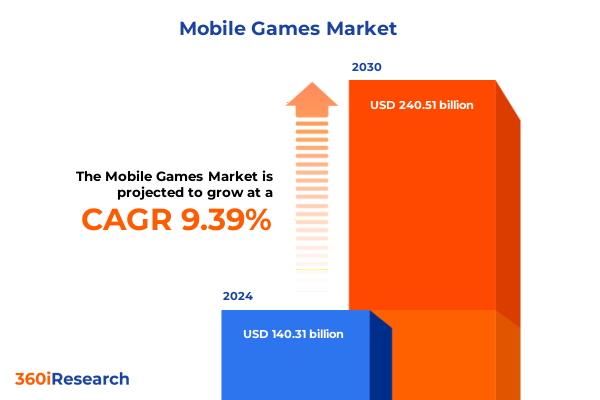The Mobile Games Market size was estimated at USD 140.31 billion in 2024 and expected to reach USD 153.86 billion in 2025, at a CAGR 9.39% to reach USD 240.51 billion by 2030.

Introduction to the Mobile Games Market
The global mobile games sector has evolved into one of the most dynamic entertainment industries, driven by continuous innovation and an expanding base of engaged users. Fueled by advances in hardware, the ubiquity of smartphones and tablets, and the rise of 5G connectivity, developers and publishers are delivering increasingly immersive experiences. From hyper-casual puzzle titles to complex massively multiplayer online adventures, the breadth of offerings caters to a diverse audience, leveraging the power of in-app cosmetics, subscription tiers, and performance optimizations that adapt to high-end, mid-range, and low-end devices alike. With user demographics spanning mature adults, teens, and young adults, and revenue models ranging from freemium structures with cosmetic items and currency packs to subscription-based and one-time purchase formats, the market demonstrates remarkable adaptability.
As competition intensifies, industry leaders must navigate shifting user expectations, regulatory changes, and emerging monetization strategies. In this summary, we explore the transformative trends reshaping mobile games, assess the cumulative impact of United States tariffs slated for 2025, uncover critical segmentation and regional insights, highlight leading companies’ positioning, and outline actionable recommendations to help strategists and decision-makers seize growth opportunities.
Transformative Shifts Defining the Mobile Games Landscape
The mobile gaming landscape has undergone transformative shifts driven by technological breakthroughs and changing consumer behaviors. Augmented reality overlays, cloud-based streaming, and cross-platform play have expanded possibilities beyond conventional touch interactions. Battle royale titles that started as solo and squad modes now integrate live events and social chat features, creating community-driven engagement loops. Meanwhile, match-3 puzzles and sudoku variants continue to captivate players seeking quick-session challenges, with killer sudoku puzzles appealing to those craving deeper logic tests.
On the revenue side, a move from pure one-time purchases toward hybrid models that blend freemium access with optional annual or monthly subscriptions has emerged, enhancing retention and lifetime value. Performance optimization for high-end devices goes hand in hand with lightweight builds tailored for low-end smartphones, ensuring broad market coverage. Developers are also leveraging real-time analytics and AI-driven personalization to refine user journeys. Against this backdrop, competition is intensifying as new entrants adopt lean monetization experiments and established studios pursue strategic collaborations. Together, these shifts are setting the stage for unprecedented creativity and commercial potential in the mobile gaming ecosystem.
Cumulative Impact of United States Tariffs on the Mobile Games Ecosystem
Anticipated United States tariffs in 2025 are poised to influence hardware costs, app store operations, and developer supply chains. Increased import levies on components used in smartphones and tablets could raise device prices, potentially dampening consumer purchasing power and slowing first-time installs. In turn, this environment may heighten competition for user attention and accelerate the pivot toward retention-driven strategies, such as in-app cosmetic drops and layered subscription offerings that stabilize revenue when hardware sales soften.
Developers relying on outsourced art, animation, or localization services may face higher overheads, compelling some to reevaluate offshore partnerships or absorb costs, with implications for production timelines and content update cadence. Moreover, app stores might adjust fee structures or promotional placements to offset diminished transaction volumes. Against this backdrop, studios that invest in efficient asset pipelines, negotiate favorable supplier agreements, and diversify monetization across cosmetic items, currency packs, one-time purchases, and subscription tiers will be better positioned to maintain profitability. Ultimately, the cumulative tariff impact will underscore the importance of agile cost management and value-driven engagement.
Key Segmentation Insights Across Game Types, Platforms, and Demographics
A thorough segmentation of the mobile games sector reveals where growth momentum and competitive intensity converge. By type of game, action experiences-spanning battle royale and first-person shooters-continue to draw large, dedicated communities in both solo and squad modes, while puzzle titles such as match-3 variants and classic or killer sudoku cater to casual play patterns and attract repeat sessions. Role-playing experiences, whether massively multiplayer online worlds or single-player narrative adventures, deliver high engagement through deep progression loops and social guilds.
Platform segmentation indicates that while Android smartphones and tablets command wide market access, iOS devices on iPad and iPhone often generate higher average revenue per user. In revenue models, freemium offerings anchored by in-app purchases of cosmetic items and currency bundles sit alongside paid-app approaches combining one-time purchase and subscription formats, including annual and monthly tiers. User demographics highlight the need to tailor experiences for mature audiences seeking strategic complexity, teens drawn to social competition, and young adults balancing immersive narratives with time-efficient play. Finally, optimizing performance across high-end devices, mid-range handsets, and budget-oriented smartphones ensures maximum reach across hardware profiles.
This comprehensive research report categorizes the Mobile Games market into clearly defined segments, providing a detailed analysis of emerging trends and precise revenue forecasts to support strategic decision-making.
- Type of Game
- Platform
- Revenue Model
- User Demographics
- Device Specifications
Key Regional Insights Shaping Mobile Gaming Strategies
Regional dynamics play a pivotal role in shaping content strategies and monetization approaches. In the Americas, strong affinity for competitive genres drives investment in e-sports integrations, live tournaments, and localized social features. Meanwhile, Europe, Middle East & Africa exhibits diverse user preferences-from simulation and puzzle titles popular in mature markets to role-playing experiences gaining traction in emerging economies-prompting publishers to localize content and partner with regional influencers. In Asia-Pacific, hyper-competitive landscapes in markets like South Korea, Japan, and China have fostered rapid adoption of subscription-based models and in-game social commerce, with mobile wallet integrations becoming a key revenue lever. Across all regions, tailoring marketing campaigns to local languages, cultural themes, and payment preferences remains essential to sustaining user acquisition and long-term engagement.
This comprehensive research report examines key regions that drive the evolution of the Mobile Games market, offering deep insights into regional trends, growth factors, and industry developments that are influencing market performance.
- Americas
- Asia-Pacific
- Europe, Middle East & Africa
Key Company Insights and Market Positioning
Leading companies are carving out distinct positions in the evolving mobile games market. Industry giants like Tencent Holdings Limited and NetEase, Inc. leverage vast online ecosystems and live-service expertise to deliver high-profile battle royale and massively multiplayer titles. Activision Blizzard, Inc., Electronic Arts Inc., and Ubisoft, Inc. extend console‐originated franchises into mobile, combining premium mechanics with freemium monetization. Magic-style startups such as Supercell Oy and King.com Ltd. excel in puzzle and casual segments, refining match-3 gameplay loops and driving retention through live events. Meanwhile, niche specialists including Niantic, Inc. and GungHo Online Entertainment, Inc. experiment with location-based AR experiences, while established publishers like Nintendo Co., Ltd. and Warner Bros Entertainment Inc. leverage iconic IP for one-time purchase and subscription-driven offers.
Emerging players, from Gameloft SE to Glu Mobile, Inc. by Electronic Arts Inc., are targeting device-specific optimization across high-end and low-end hardware to maximize addressable audiences. Companies such as Com2uS Corp. and Konami Digital Entertainment B.V. focus on role-playing mechanics and collectible economics, while The Walt Disney Company integrates branded events for young adult demographics. Together, these varied approaches illustrate how diversified portfolios and strategic partnerships define leadership in mobile gaming.
This comprehensive research report delivers an in-depth overview of the principal market players in the Mobile Games market, evaluating their market share, strategic initiatives, and competitive positioning to illuminate the factors shaping the competitive landscape.
- Activision Blizzard, Inc.
- BANDAI NAMCO MOBILE S.L.
- Com2uS Corp.
- Electronic Arts Inc.
- Gameloft SE
- GamePix S.r.l.
- GamesHub
- Glu Mobile, Inc. by Electronic Arts Inc.
- GungHo Online Entertainment, Inc.
- King.com Ltd.
- KONAMI DIGITAL ENTERTAINMENT B.V.
- NCSOFT CORPORATION
- NetEase, Inc.
- Niantic, Inc.
- Nintendo Co., Ltd.
- Peak Oyun Yazılım ve Pazarlama A.Ş.
- Rovio Entertainment Corporation
- Supercell Oy
- Tencent Holdings Limited
- The Game Awards
- The Walt Disney Company
- Ubisoft, Inc.
- Warner Bros Entertainment Inc.
- Zynga Inc. by Take-Two Interactive Software, Inc.
Actionable Recommendations for Mobile Games Industry Leaders
To stay ahead in this competitive environment, industry leaders should consider several strategic actions. First, optimize cross-platform performance to ensure seamless experiences from low-end smartphones to the latest tablets and flagship devices. Second, evolve monetization by blending cosmetic offerings and currency packs with flexible subscription tiers-balancing annual and monthly options-to enhance lifetime value. Third, deepen regional engagement through culturally resonant localization, influencer partnerships, and tailored live events that reflect distinct preferences in the Americas, Europe, Middle East & Africa, and Asia-Pacific. Fourth, safeguard production efficiency by diversifying supplier networks and investing in automated asset-generation pipelines, mitigating cost pressures from tariffs and ensuring consistent content updates. Finally, harness analytics and AI-driven personalization to refine onboarding flows, predict churn signals, and deliver contextually relevant offers at scale-driving both retention and profitable growth.
Explore AI-driven insights for the Mobile Games market with ResearchAI on our online platform, providing deeper, data-backed market analysis.
Ask ResearchAI anything
World's First Innovative Al for Market Research
Conclusion and Strategic Outlook
The mobile games market stands at an inflection point, where innovation, market segmentation, and strategic foresight converge to determine success. As augmented reality, cloud gaming, and evolving revenue models reshape player expectations, companies that align product roadmaps with user demographics, device capabilities, and regional nuances will capture new growth vectors. Navigating the headwinds of tariffs and supply chain shifts demands agile cost controls and diversified partner ecosystems. Simultaneously, embracing data-driven personalization and hybrid monetization strategies will reinforce engagement and lifetime value across mature, teenage, and young adult segments. By synthesizing these insights, mobile game stakeholders can craft compelling experiences that resonate globally and foster sustainable competitive advantage.
This section provides a structured overview of the report, outlining key chapters and topics covered for easy reference in our Mobile Games market comprehensive research report.
- Preface
- Research Methodology
- Executive Summary
- Market Overview
- Market Dynamics
- Market Insights
- Cumulative Impact of United States Tariffs 2025
- Mobile Games Market, by Type of Game
- Mobile Games Market, by Platform
- Mobile Games Market, by Revenue Model
- Mobile Games Market, by User Demographics
- Mobile Games Market, by Device Specifications
- Americas Mobile Games Market
- Asia-Pacific Mobile Games Market
- Europe, Middle East & Africa Mobile Games Market
- Competitive Landscape
- ResearchAI
- ResearchStatistics
- ResearchContacts
- ResearchArticles
- Appendix
- List of Figures [Total: 26]
- List of Tables [Total: 760 ]
Call to Action: Contact Ketan Rohom for the Full Report
To gain comprehensive insights and actionable data that will power your next strategic moves, reach out to Ketan Rohom (Associate Director, Sales & Marketing) to secure your copy of the full market research report. He will guide you through tailored solutions, detailed segmentation analyses, and expert recommendations designed to elevate your position in the dynamic mobile games landscape.

- How big is the Mobile Games Market?
- What is the Mobile Games Market growth?
- When do I get the report?
- In what format does this report get delivered to me?
- How long has 360iResearch been around?
- What if I have a question about your reports?
- Can I share this report with my team?
- Can I use your research in my presentation?




